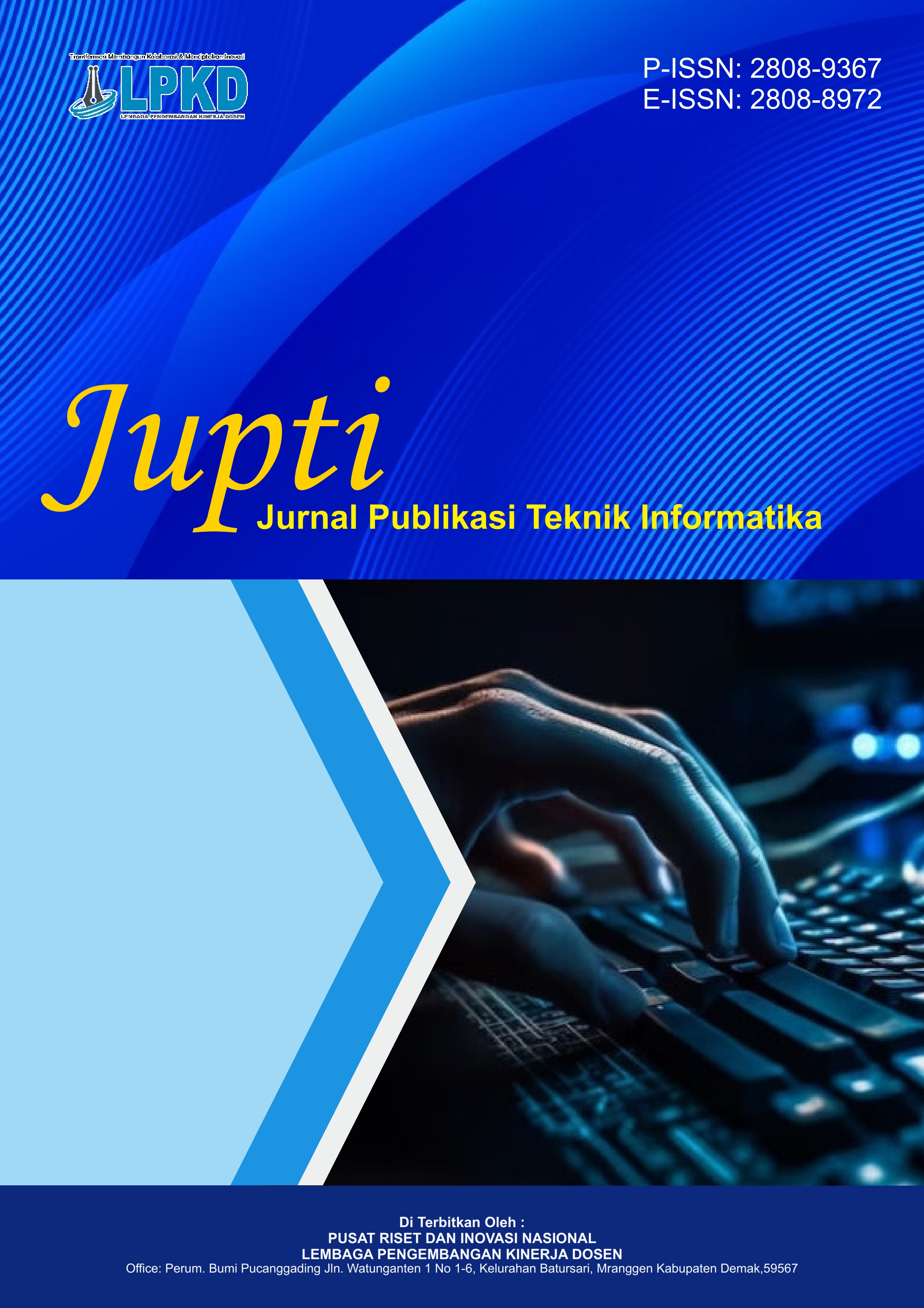Klasifikasi Tingkat Kematangan Buah Kelapa Sawit Menggunakan Metode Convolutional Neural Network
DOI:
https://doi.org/10.55606/jupti.v4i3.5841Keywords:
Convolutional Networks, Image Analysis, Maturity Classification, Model CNN, Palm FruitAbstract
Classifying the ripeness level of oil palm fruits represents a critical aspect of the oil palm industry that dominates Indonesia's economy. This research aims to develop and evaluate a Convolutional Neural Network (CNN) model to automatically, objectively, and accurately classify the ripeness level of oil palm fruits based on digital image analysis. The underlying problem of this research is the manual harvesting practice that relies on subjective assessment by harvesters, resulting in inconsistency and substantial economic losses. The research approach employs a quantitative experimental methodology with a dataset of 1,840 digital images of oil palm fruits balanced across four ripeness categories (unripe, semi-ripe, ripe, overripe). Image preprocessing was performed to standardize input with a data split of 80% training and 20% testing. The implemented CNN model achieved an average accuracy of 76.52% with optimal accuracy of 82.61%, precision of 0.77, recall of 0.77, and F1-score of 0.76 from five independent test runs. RGB profile analysis revealed a significant correlation between color pigment values and ripeness level, with extreme categories (unripe and ripe) achieving accuracy >95%, while transitional categories (semi-ripe) demonstrated higher challenges. Per-category results showed excellent F1-scores (0.946–0.983) for all classes, indicating that the model learned meaningful ripeness indicators based on biological pigment physiology. System implementation was complemented with a user-friendly Graphical User Interface (GUI) based on MATLAB, enabling non-technical operators to use the model directly. Functional black-box testing demonstrated a 100% pass rate, validating the system's readiness for operational deployment. In conclusion, CNN can be implemented as a practical solution for harvest automation that enhances objectivity, consistency, and efficiency in harvest timing determination, with positive implications for product quality, industry sustainability, and economic value added for Indonesian oil palm farmers.
Keywords: Ripeness classification, oil palm fruit, Convolutional Neural Network, digital image processing, harvest automation, machine learning, RGB analysis
References
Afandy, I., Ahmad, B. N., & Amartharizqi, M. R. (2024). Klasifikasi kematangan sawit menggunakan metode Convolutional Neural Network (CNN) dengan transfer learning Xception. Jurnal Ilmiah Teknologi Informasi dan Robotika, 6(2), 88–98.
Aguswandi, L. H., Syafitri, D., & Sujaka, T. T. (2025, March). Pemodelan prediktif menggunakan algoritma backpropagation. In Prosiding Seminar Nasional Teknologi, Inovasi, dan Ekonomi (SETIE) (pp. 149–157).
Amalia, F., Cholissodin, I., & Soebroto, A. A. (2020). Pelatihan feedforward neural network menggunakan particle swarm optimization untuk peramalan harga saham. Jurnal Pengembangan Teknologi Informasi dan Ilmu Komputer, 4(10), 3680–3687.
Anwar, K. (2025). Sistem deteksi wajah berbasis deep learning menggunakan Convolutional Neural Network (CNN). Journal of Computer Science and Information Technology, 1(2), 46–52.
Aryadi, I., & Suhendar, A. (2024). Implementasi arsitektur Xception dalam menentukan kematangan tandan buah segar kelapa sawit. Jutisi: Jurnal Ilmiah Teknik Informatika dan Sistem Informasi, 13(3).
Batubara, N. A., & Awangga, R. M. (2020). Tutorial object detection plate number with convolution neural network (CNN) (Vol. 1). Kreatif.
Juliardi, S. E., & Fachrudin, H. T. (2022). Penilaian perkebunan kelapa sawit. Merdeka Kreasi Group.
Pakaja, F., Naba, A., & Purwanto, P. (2012). Peramalan penjualan mobil menggunakan jaringan syaraf tiruan dan certainty factor. Jurnal EECCIS, 6(1), 23–28.
Ramadhana, A. W. S., Aulia, A. D., & Ulum, T. (2024). Keunggulan komparatif ekspor kopi di Indonesia. Journal of Economics, Business, Accounting and Management, 2(1), 110–123.
Rustiyana, R., Lase, M. C. M., Imamah, N., Yendri, O., & Judijanto, L. (2025). Pengolahan citra digital: Digital image processing. PT Sonpedia Publishing Indonesia.
Saptadi, N. T. S., Kristiawan, H., Supriadi, A., Yusuf, M., Alam, S., Sumarta, S. C., ... & Soleh, O. (2025). Kapita selekta teknologi informasi. Sada Kurnia Pustaka.
Siregar, A. C., Poetro, B. S. W., Octariadi, B. C., Robet, R., & Sucipto, S. (2025). Buku ajar pengolahan citra digital. PT Green Pustaka Indonesia.
Sutawinaya, I. P., Astawa, I. N. G. A., & Hariyanti, N. K. D. (2017). Perbandingan metode jaringan saraf tiruan pada peramalan curah hujan. Logic: Jurnal Rancang Bangun dan Teknologi, 17(2), 92–97.
Syahdilan, A., & Tanjung, M. A. P. (2024). Implementasi algoritma Discrete Wavelet Transform untuk menambahkan invisible watermarking pada citra digital. JATI (Jurnal Mahasiswa Teknik Informatika), 8(6), 12205–12217.
Utomo, D., & Utomo, T. F. (2025). Deep learning: Dasar teori dan implementasi dengan Python dan Keras. Diandra Kreatif; Penalicious.
Wuryandari, M. D., & Afrianto, I. (2012). Perbandingan metode jaringan saraf tiruan backpropagation dan learning vector quantization pada pengenalan wajah. Jurnal Komputer dan Informatika (Komputa), 1(1), 45–51.
Downloads
Published
How to Cite
Issue
Section
License
Copyright (c) 2025 Jurnal Publikasi Teknik Informatika

This work is licensed under a Creative Commons Attribution-ShareAlike 4.0 International License.








